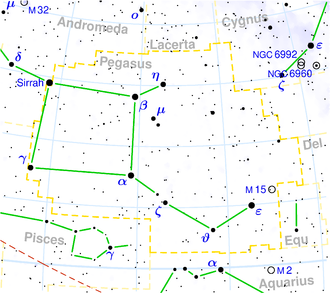NGC 7620
| Galaxie NGC 7620 | |
|---|---|
 | |
| SDSS-Aufnahme | |
| AladinLite | |
| Sternbild | Pegasus |
| Position Äquinoktium: J2000.0, Epoche: J2000.0 | |
| Rektaszension | 23h 20m 05,6s[1] |
| Deklination | +24° 13′ 15″[1] |
| Erscheinungsbild | |
| Morphologischer Typ | Scd: / Sbrst / HII[1] |
| Helligkeit (visuell) | 12,9 mag[2] |
| Helligkeit (B-Band) | 13,6 mag[2] |
| Winkelausdehnung | 1.10 × 1.1[2] |
| Flächenhelligkeit | 13,0 mag/arcmin²[2] |
| Physikalische Daten | |
| Rotverschiebung | 0.031962 ± 0.000037[1] |
| Radialgeschwindigkeit | (9582 ± 11) km/s[1] |
| Hubbledistanz vrad / H0 | (413 ± 29) · 106 Lj (126,7 ± 8,9) Mpc [1] |
| Geschichte | |
| Entdeckung | Albert Marth |
| Entdeckungsdatum | 5. September 1864 |
| Katalogbezeichnungen | |
| NGC 7620 • UGC 12520 • PGC 71106 • IRAS 23176+2356 • 2MASX J23200566+2413160 • GC 6187 • | |
NGC 7620 ist eine Spiralgalaxie vom Hubble-Typ Scd im Sternbild Pegasus am Nordsternhimmel, die schätzungsweise 413 Millionen Lichtjahre von der Milchstraße entfernt ist. Sie wird als Starburstgalaxie mit ausgeprägten Sternentstehungsgebieten beschrieben.
Entdeckt wurde das Objekt am 5. September 1864 von Albert Marth.[3]
Einzelnachweise
Auf dieser Seite verwendete Medien
Autor/Urheber: Sloan Digital Sky Survey, Lizenz: CC BY 4.0
The sky image is obtained by Sloan Digital Sky Survey, DR14 with SciServer.
Angle of view: 4' × 4' (0.3" per pixel), north is up.
Details on the image processing pipeline: https://www.sdss.org/dr14/imaging/jpg-images-on-skyserver/



